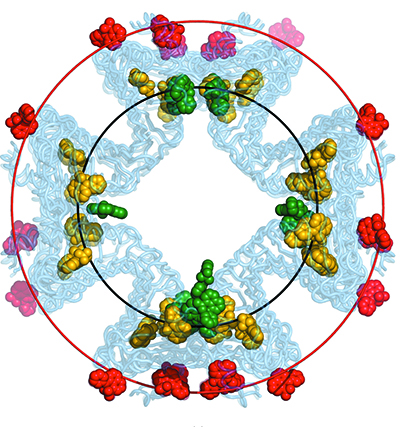Modulated crystal structure of St John’s wort PR-10 protein
 The proteins expressed by plants under stressful conditions
(such as drought, salinity or pathogen invasion), known as pathogenesis-related
(PR) proteins, have been divided into 17 classes. The members of most of these
classes have well known biological activity. PR proteins of class 10 (PR-10)
are very unusual, because no unique function can be assigned to them despite
their abundance, their co-existence as many isoforms in one plant, and many years
of study.
The proteins expressed by plants under stressful conditions
(such as drought, salinity or pathogen invasion), known as pathogenesis-related
(PR) proteins, have been divided into 17 classes. The members of most of these
classes have well known biological activity. PR proteins of class 10 (PR-10)
are very unusual, because no unique function can be assigned to them despite
their abundance, their co-existence as many isoforms in one plant, and many years
of study.
Hyp-1 is a PR-10 protein from St John’s wort (the medicinal herb Hypericum perforatum). To shed more light on Hyp-1 and on PR-10 proteins in general, Hyp-1 was crystallized in complex with the fluorescent probe 8-anilino-1-naphthalene sulfonate (ANS), and the crystal structure was solved by molecular replacement using Phaser, despite tetartohedral twinning and a huge unit cell with severe pseudosymmetry, including sevenfold translational non-crystallographic symmetry (tNCS) along c. tNCS was handled in Phaser using new maximum-likelihood algorithms, but the space group ambiguity introduced by the twinning had to be overcome by searching for 56 protein molecules in P1 symmetry [Sliwiak, J. et al. (2014). Acta Cryst. D70, 471-480; doi: 10.1107/S1399004713030319]. Ultimately, the crystal structure of the Hyp-1/ANS complex could be described at 2.4 Å in the C2 space group, with 28 well ordered protein molecules and 89 ANS ligands, 60 of which populate three novel binding sites of this PR-10 molecule. In its description presented in detail by Sliwiak, J. et al. [(2015). Acta Cryst. D71, 829-843; doi: 10.1107/S1399004715001388], this superstructure can be considered as commensurately modulated within a supercell sevenfold extended in the c direction, consistent with a peculiar modulation in the diffraction pattern, showing intensity crests at l = 7n ± (0,3). The paper also discusses the possible pitfalls of twinning detection in cases of severe pseudosymmetry.
In a recent interview Professor Mariusz Jaskólski explains why he feels that crystallography in Poland is so strong, firstly because of the long standing school of crystallography based there and secondly how crystallography plays on a range of sciences which Poland already excels in, such as physics, biology, medicine and mathematics.
Jaskólski’s work with co-workers based in Poland, United Kingdom and the United States [Sliwiak, J. et al. (2015). Acta Cryst. D71, 829-843; doi: 10.1107/S1399004715001388] is an excellent example of the collaborative efforts, so frequent in our discipline.


